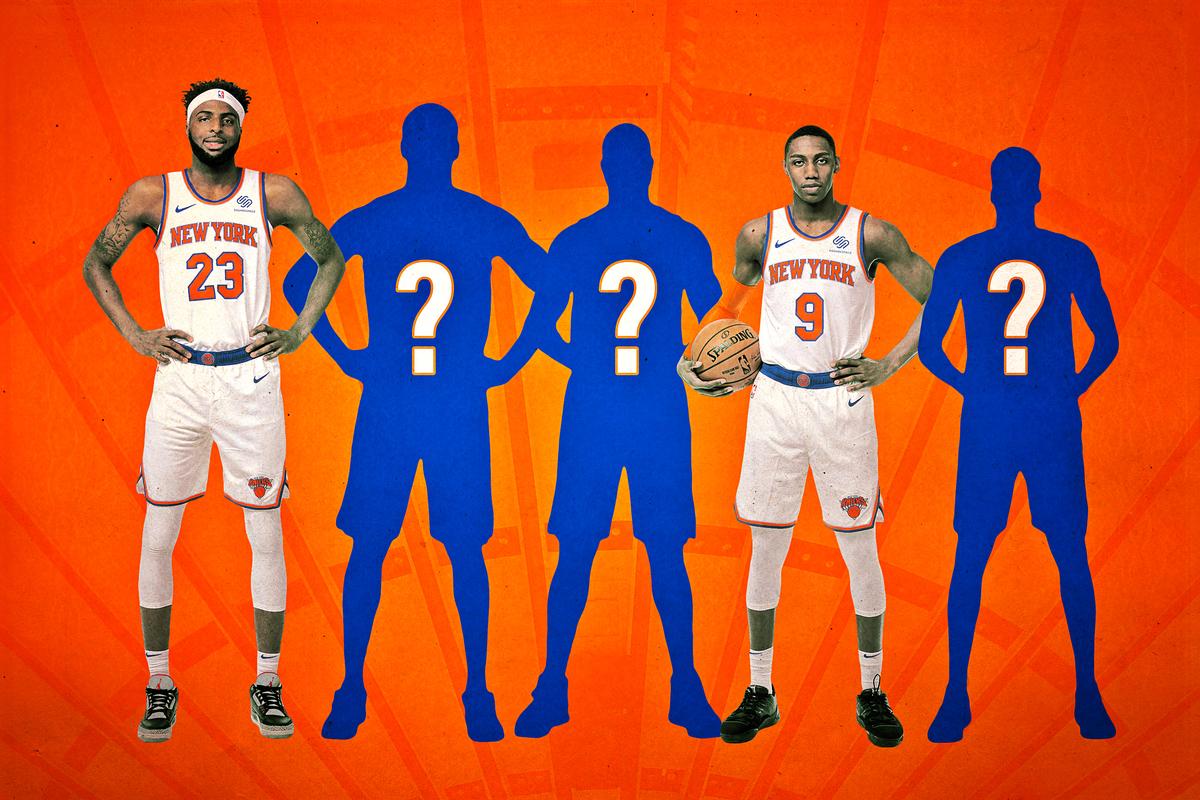
At this point, you almost have to admire the Knicks for their commitment to self-sabotage. One would think that a storied franchise with one of the greatest market advantages in sports might be able to succeed in spite of itself, like the Lakers riding a wave of dysfunction all the way to LeBron James. Failing that, the Knicks should at least have been able to hit on their draft picks or free-agent signings occasionally enough to camouflage their broader organizational failing. Not so. The rest of the league may work in cycles, but the Knicks stand impervious to lasting improvement.
The firing of head coach David Fizdale is symptomatic of this remarkable feat of mismanagement, in the way that general fatigue is a symptom of the ebola virus. The actual problems involved are so much deeper and so much worse; even if Fizdale had coached the team perfectly this season, he never really stood a chance considering the scale of what ails the franchise. Knicks president Steve Mills and general manager Scott Perry made that much clear when they held an impromptu press conference 10 games into the season to express displeasure in the team’s performance without for a second interrogating the processes that brought that team together in the first place.
So let’s do it for them. New York has the worst record (4-19) in the NBA and a roster deserving of it. Fixing the Knicks is a big job, but here is an 11-point plan to at least run them more sensibly:
1. Trace the current problems to their root causes.
We can nitpick over rotation decisions and contract specifics all we want, but none of it really matters without a thorough accounting of how the current Knicks came to be. Start with the team’s damning premise—that this is a good NBA roster, to paraphrase Mills and Perry—and work backward into how they convinced themselves it could possibly be true. Hypothetically:
The Knicks’ brass expect the team to perform better because they believe that the roster makes sense → the roster makes sense because it satisfies their belief of what a team needs to win → size is a meaningful differentiator between winning and losing → there is an advantage to be gained from putting as much size on the floor as possible → the individual performance of bigger players like Julius Randle, Marcus Morris, Bobby Portis, etc. contributes to a winning cause.
Within every basketball decision, there are dozens of places for a team to go wrong. Take, for instance, signing a nonsuperstar player like Randle. Maybe the Knicks fundamentally misunderstood the Lakers and Pelicans cast-off and the meaning of his box-score numbers. Clearly the front office underestimated the importance of floor spacing and overestimated the value of stringing together a bunch of bigs—the combination of which suggests a strange view of the modern game. There’s not only the question of why the Knicks signed the players they did, but how they allocated their resources. Even if you like Randle’s game, does pulling him from a tepid market really require a three-year, $62 million offer?
For the Knicks to improve, they need to understand where they went wrong and isolate which processes—or people—led them there.
2. Practice actual accountability.
When the executives at the helm of an enormously popular franchise fire the team’s head coach without so much as a word for more than two days, the burden of explanation falls to others—players and, in this case, Mike Miller, the interim coach replacing Fizdale—who had nothing to do with the decision. Mills and Perry said they felt an “obligation” to address the media back at the 10-game mark, largely to intimate that they weren’t mad at the Knicks, just disappointed. When it came time to act, they dismissed Fizdale and said nothing. Don’t confuse this as a case of media grousing over some arbitrary lack of availability; you don’t need a block quote from Mills to cover the team’s current debacle. Yet by skirting that responsibility, Mills and Perry forced players into an awkward role as frontline spokesmen for (and against?) the firing of their own coach. You can’t expect players to sacrifice for the team when the team doesn’t even do the bare minimum to protect them.
3. Focus on creating a healthy developmental environment.
Let’s abandon all pretense that the team with the worst net rating in the league is actually, secretly good. The top priorities on the court this season are: identifying the prospects on the team worthy of continued investment and developing those players as much as these circumstances allow. Every decision made by Miller should come in service of furthering the careers of the Knicks’ best young players. Sometimes that will mean putting a veteran structure around them. Inevitably, it will require the team to stomach some nauseating mistakes. The product on the court needs to work, in a functional sense. It just doesn’t need to win. (On a related note: Don’t even bother with tanking. There’s no need to force what this roster will bring naturally.)
4. Don’t be precious.
With apologies to RJ Barrett, there isn’t a single player on the Knicks’ roster who should be considered untouchable.
5. Invest in easier points.
These are lean times for the Knicks, who have managed the worst half-court offense and the worst transition offense this season, per Synergy Sports. It’s hard to escape the former; without savvier creators or dramatically different spacing, attempts to score against a set defense will always feel like pulling blood from bricks. With that being the case, the Knicks should disregard the premise as much as possible. Even though New York has struggled on the break, those struggles are relative. It’s always a better proposition for an offense to roll downhill, before a defense can get itself in order. This isn’t exactly a roster built for speed, but the Knicks haven’t tried their luck enough in transition.
If Randle, Barrett, Damyean Dotson, or any point guard pulls down a board, they should make a run for it—not only for the hope of scoring, but as a means of developmental relief. New York has to find ways to reduce the friction of its offense—not only for the sake of scoring more, but in giving young ball handlers the room to make actual reads. It’s difficult to create a three-on-two advantage when defenders are sagging off of multiple Knicks into the paint. So use the open floor as a lab. It’s a bit artificial, but at the very least New York can put players like Barrett and Frank Ntilikina through the paces of manipulating the defense without quite so many variables.
6. Start Mitchell Robinson over Randle, if you can.
It is in the best interests of the Knicks to get Robinson on the floor as much as possible this season, even as he does his damnedest to foul his way off of it. Randle isn’t good enough, important enough, or valuable enough as a trade candidate to stand in the way of that. Controlling Robinson’s foul trouble might be the single most important project of New York’s season. How can the 21-year-old find his way without playing as much as possible alongside the most reliable teammates the Knicks have to offer? Robinson should play more with Taj Gibson not because Gibson is his optimal frontcourt partner, but because it provides Robinson the best opportunity to grow. Let him learn from a veteran who made a career out of defensive positioning. Control the first line with defenders like Ntilikina and Morris, and protect Robinson from panic fouls in the process. The starting lineup, as it is, isn’t really the Knicks’ problem. It just isn’t any kind of solution, either.
7. Accept the sunk costs with Dennis Smith Jr.
Difficult as this might be, the Knicks need to be honest about Smith—and, more importantly, what he might be costing their other prospects. It’s not a stretch to say that Smith has been New York’s worst rotation player this season, a distinction that’s especially painful in light of his role within the offense. Other prospects are reliant on Smith to play in flow and run an offense to balance. That isn’t yet in his repertoire, which complicates the work of Robinson, Dotson, and Kevin Knox, in particular. Smith is the lone player acquired in the Kristaps Porzingis trade still on the Knicks’ roster. (Two future first-round picks acquired in the deal have yet to convey.) All the same, New York shouldn’t let sunk costs get in the way of more pressing developmental concerns. Entrust reserve point guard duties to Elfrid Payton for the sake of running the second unit more competently.
8. Keep Barrett at shooting guard as much as possible.
In an effort to spread the floor with these limited resources, it might be tempting to shift Barrett up a position to small forward. Doing so, however, could take away the best advantage Barrett has going: the strength to drive through smaller guards and bowl them out of his way.
9. Push the trade market on Morris and Portis, in particular.
After spending all their cap space on players who don’t really move the franchise forward, the Knicks can’t afford to then compound their mistake by not trading players on expiring contracts. Morris is the most pressing; plenty of playoff teams out West could use someone like Morris to body up the bigger wings of the contending set. Landing something—anything—in return would be better for the Knicks than running out the clock on a one-year agreement. New York can afford a bit more patience with Portis, who has a $15.8 million team option for next season. Trading Portis is preferable to declining his option outright, though at least there’s some flexibility in the choice.
10. Get comfortable with cap room.
The Knicks have never been great with the concept of delayed gratification, grasping instead at whatever player is nearest and willing to take their money. This has to change. Franchises are allowed to build toward something more than a year away. They have options available to them other than chasing the biggest name in the market and then impulse-signing four players at the same position when things don’t pan out. The greatest advantage a rebuilding team has is time. When other franchises are desperate to unload salary before the deadline, the Knicks could take it on for a draft pick. If a contender is desperate to make a season-saving trade but needs a third team to facilitate, the Knicks could lend a hand for a prospect or a pick swap.
The reason to clear cap space isn’t to chase superstars. It’s to build something lasting that, in a few years’ time, might entice them on its own. So you start to find takers for the players you don’t explicitly need. You ask around about interest in Gibson, Payton, and Wayne Ellington. If it’s not there by June 28, 2020—three days after the draft—then you cut them loose and pay their marginal guarantees for next season, clearing over $20 million in the process. The tradition of the Knicks lies in costly mistakes and bloated cap sheets. Going younger means staying agile until the perfect opportunity strikes.
11. Sell the team.
The only point that really matters, and the most distant possibility of all. If you really want to talk root causes, the man who hired every sketchy decision-maker, signed off on every underwhelming coach, and thereby allowed for every mistake in recent franchise history remains in control of the whole thing. James Dolan is the elephant in the room who owns the whole building.

